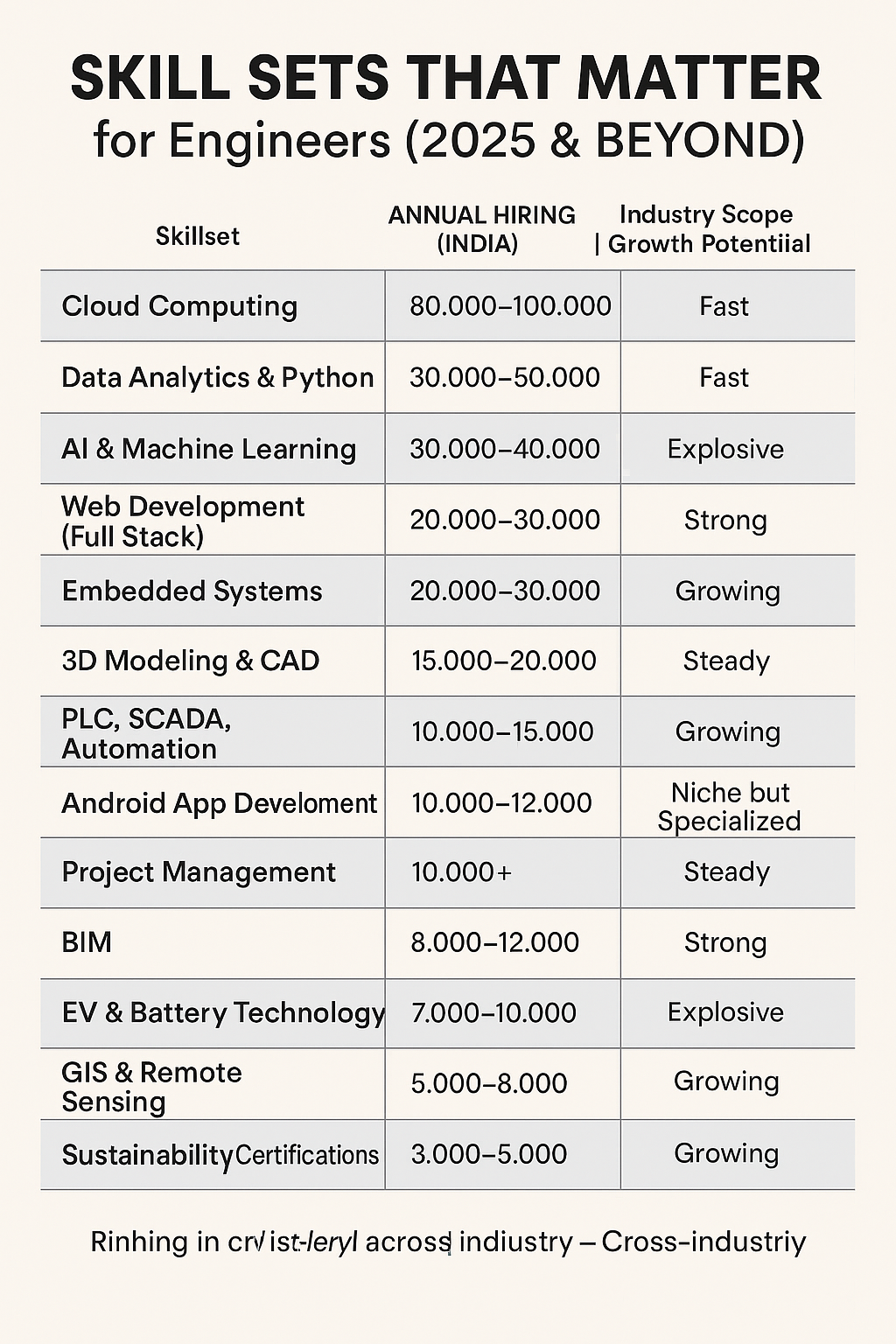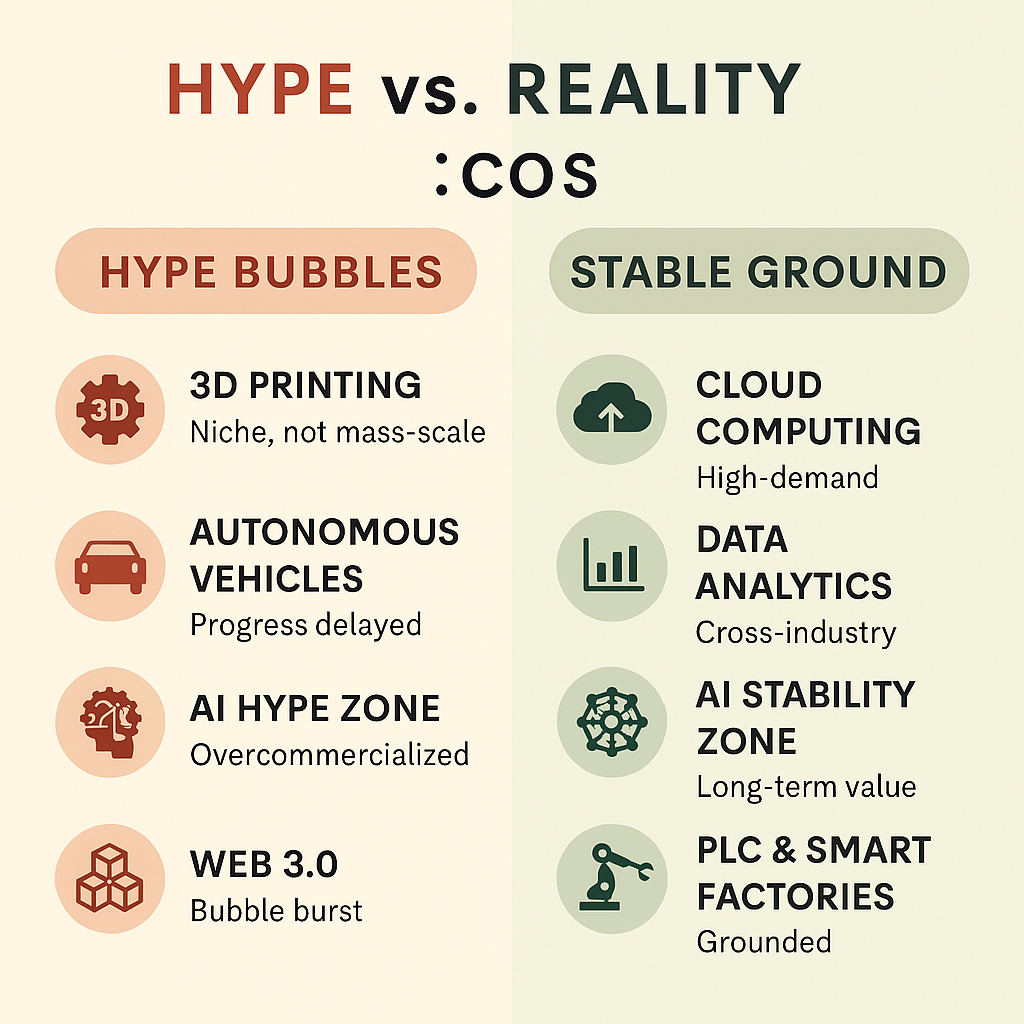User Ideas / Prospects
In today’s fast-evolving job market, engineering graduates in India are bombarded with promises of futuristic careers in sectors that appear to be booming.
But beneath the flashy projections and viral trends, many of these so-called "rising sectors" may actually be hype bubbles—they grow rapidly on public perception, not on stable industrial foundations.
This report is not just a forecast. It’s a protective insight for students and job seekers, based on real data, peer debates, and market research.
The Hype Bubbles: Danger Zones for Engineers
1. 3D Printing: Overstated for Mass Manufacturing
The Hype: Supposed to revolutionize construction and mass production.
The Reality: Valuable in prototyping and R&D, but not scalable for everyday, high-volume manufacturing.
2. Autonomous Vehicles: Progress Delayed
The Hype: Full self-driving cars by 2025.
The Reality: Regulatory, safety, and infrastructure barriers make mass deployment years away. India’s public roads are not near-ready.
3. AI Hype Zone: Non-Foundational, Over-Commercialized AI
The Hype: Generative AI will rapidly replace most content creators, coders, and engineers.
The Reality:
Most "prompt engineering" jobs are quickly disappearing or evolving.
AI tools for surface-level content and simple coding tasks are already saturated.
Many companies face hallucination, privacy, and ethical challenges, leading to slower adoption than headlines suggest.
Caution: Careers built only around using AI tools without understanding the algorithms, ethics, or product integration are highly unstable.
4. Web 3.0: The Known Bubble
The Hype: Blockchain will dominate the next internet wave.
The Reality: Crypto winter, regulatory pushback, and limited enterprise adoption proved the bubble burst.
The Stable Ground: Careers with Real Demand 1. Cloud Computing
Annual Hiring: ~80,000–100,000 in India.
Why It’s Stable: Cloud is the backbone of digital transformation across every industry.
2. Data Analytics with Domain Expertise
Annual Hiring: ~70,000–100,000.
Why It’s Stable: Business decisions increasingly rely on real-time data.
3. AI Stability Zone: Core, Industrial, and Applied AI
Annual Hiring: ~40,000–50,000.
Why It’s Stable:
AI for medical diagnostics, supply chain optimization, manufacturing quality control, and predictive maintenance has long-term real-world demand.
Growth is grounded in solving specific industry problems, not just creating flashy content.
Solid AI Careers:
Computer vision engineers
AI-driven control system developers
NLP in linguistics and healthcare
Robotics AI specialists
4. PLC & Smart Factories (Industry 4.0)
Annual Hiring: ~10,000–15,000.
Why It’s Stable: Automation is reshaping Indian factories and logistics.
5. Embedded Systems for EV and IoT
Annual Hiring: ~20,000–30,000.
Why It’s Stable: Real engineering demand in smart products and EV hardware is growing.
6. Sustainability Engineering
Annual Hiring: Growing steadily.
Why It’s Stable: Supported by global climate policies and India’s sustainability push.
Core Lesson for Engineering Students
Don’t follow the noise. Follow real-world problems.
Careers Skills Domain Reality Check
| 3D Printing | Niche, not mass-scale |
| Autonomous Vehicles | Delayed, limited hiring |
| Non-Foundational GenAI | Overcrowded, unstable |
| Web 3.0 | Bubble burst |
| Cloud Computing | High-demand, solid growth |
| Data Analytics | Stable, cross-industry |
| Core AI (Industrial, Applied) | Real jobs, long-term value |
| PLC & Smart Factories | Grounded, growing |
| Embedded/IoT Systems | Industry-supported growth |
| Sustainability Engineering | Policy-backed expansion |
The Core Lesson: "Hyped" Careers Share These Traits:
Characteristics Bubble Indicators
| Massive media coverage | ✅ Bubble risk |
| Few profitable use-cases | ✅ Bubble risk |
| Regulatory hurdles | ✅ Bubble risk |
| Low barrier to entry | ✅ Rapid saturation |
| Heavy reliance on funding | ✅ Prone to collapse |
Why This Matters
Chasing hype-driven jobs can cost engineering students valuable years and expensive reskilling cycles. The Indian engineering job market is brutally competitive. You need to be careful where you place your bets.
The responsibility lies with engineering educators, industry mentors, and journalists like us to separate short-lived bubbles from sustainable career paths.
Final Thought
Before aligning your career with a trend, always ask:
Is it solving an immediate, real-world industrial problem?
Are companies hiring at scale or just experimenting?
Does the field have consistent investment or just viral attention?
When the answer is "no," it’s probably a bubble waiting to burst.
Let’s commit to building careers with solid foundations—not air castles sold by hype.
Dear All Engineers,
I’m excited to share an important milestone from our journey at Yojnakar Innovation’s project – EngineersHeaven.org, an online community built to promote engineering and make it a social norm.
We’ve just successfully completed our first YouTube video series:
"Mechanical Engineering Job Market Trends of 2025 for Career Advancements"
1. Introduction
https://www.engineersheaven.org/video/view/30
2. Challenges and Opportunity Part 1
https://www.engineersheaven.org/video/view/31
3. Challenges and Opportunity Part 2
https://www.engineersheaven.org/video/view/32
4. Must Have Skills for Mechanical Engineers Part 1
https://www.engineersheaven.org/video/view/33
5. Must Have Skills for Mechanical Engineers Part 2
https://www.engineersheaven.org/video/view/39
6. Self Employment Opportunities in Field Of Mechanical Engineering In India.
https://www.engineersheaven.org/video/view/34
7. Ways of Corruptions Needs to Stop Indian Mechanical Engineering.
https://www.engineersheaven.org/video/view/35
8. Engineering Ethics that must needs to Maintain by Engineers Regardless Branch or Faculty.
https://www.engineersheaven.org/video/view/31
9. Real Life Heroes / Role Model Mechanical Engineers Of India.
https://www.engineersheaven.org/video/view/38
Why This Series Matters?
Mechanical Engineering is a vast, evolving, and dynamic field.
To thrive, engineers must continuously:
Adapt to new technologies
Upgrade their skills
Tackle new industry challenges
This video series is designed to help mechanical engineers across India stay aligned with job market trends for career growth and future opportunities.
Our Contribution to Engineering
This is a humble effort by me and my team to support engineers and contribute meaningfully to our profession.
Since this is our first series, your feedback, encouragement, and support will inspire us to keep creating valuable content for the engineering community.
Thank you in advance!
Looking forward to connecting and building this movement together.
Comparative Analysis of Job Market Trends Across Mainstream Engineering Fields
1. Introduction
The engineering job market has undergone significant changes over the last five years, influenced by technological advancements, industry demand, and regional economic factors. This report provides a comparative analysis of job trends across key engineering disciplines globally and in India, backed by industry reports and expert analysis.
2. Overview of Engineering Fields Considered
Mechanical Engineering
Civil Engineering
Electrical Engineering
Electronics Engineering
Computer Science & Software Engineering
Chemical Engineering
Aerospace Engineering
3. Job Growth Trends (2019-2024)
Engineering FieldGlobal Job Growth (%)India Job Growth (%)Key Drivers
Mechanical +5% +6% Automation, Robotics, Renewable Energy (Source: World Economic Forum, Engineering Workforce Report 2023) Civil +3% +4% Urbanization, Smart Cities, Infrastructure Development (Source: India Infrastructure Report 2023) Electrical +4% +5% Power Grids, Renewable Energy, Electric Vehicles (EVs) (Source: International Energy Agency, Global Energy Outlook 2024) Electronics +2% +3% Consumer Electronics, Semiconductor Industry (Source: Semiconductor Industry Association 2023) Computer Science +12% +15% AI, Cloud Computing, Cybersecurity, Software Development (Source: Gartner IT Jobs Report 2024) Chemical +1% +2% Sustainable Materials, Green Chemistry, Pharmaceuticals (Source: Global Chemical Industry Report 2023) Aerospace +6% +7% Space Exploration, Defense, Private Aviation Growth (Source: NASA & ISRO Employment Reports 2023) 4. Key Findings & Comparative Analysis 4.1 Computer Science & Software Engineering
Highest Growth Rate due to demand in AI, ML, cybersecurity, and cloud technologies. (Source: McKinsey Digital Workforce Report 2024)
Remote Work Flexibility allows companies to hire globally, increasing competition.
India as an IT Hub has significantly contributed to its rapid job market expansion. (Source: NASSCOM India IT Jobs Report 2023)
4.2 Mechanical, Electrical, and Civil Engineering
Steady Growth but not as exponential as software fields. (Source: Bureau of Labor Statistics, Engineering Job Outlook 2024)
Automation & AI Integration is reshaping traditional roles.
Renewable Energy & EVs boosting opportunities in Electrical and Mechanical fields.
Smart Cities & Infrastructure Growth supporting Civil Engineering job demand. (Source: World Bank Infrastructure Investment Report 2023)
4.3 Electronics & Chemical Engineering
Slower Growth due to automation reducing manual design and manufacturing roles.
Semiconductor Industry Boom creating niche opportunities in Electronics. (Source: Semiconductor Industry Association 2023)
Sustainability Focus in Chemical Engineering opening new doors in green chemistry. (Source: Global Chemical Engineering Outlook 2024)
4.4 Aerospace Engineering
Stable to Growing Market with increased investments in private space exploration (SpaceX, ISRO, Blue Origin, etc.).
Defense & Commercial Aviation driving demand. (Source: Boeing & Airbus Industry Reports 2023)
5. Future Prospects & Emerging Trends
Interdisciplinary Skills: Engineers combining traditional skills with AI, IoT, and robotics will have a competitive edge. (Source: Harvard Business Review 2024)
Sustainability & Green Engineering: High demand in renewable energy, electric vehicles, and waste management.
Space & Defense Sector Expansion: Increasing aerospace engineering opportunities.
Upskilling & Reskilling: Engineers must adapt to digital transformations to remain relevant. (Source: LinkedIn Workforce Report 2023)
6. Conclusion
While Computer Science & Software Engineering leads in job market expansion, other engineering fields remain essential, with opportunities evolving due to technological shifts. Engineers who integrate software, automation, and sustainability into their expertise will have higher employability in the future.
Sources & References:
World Economic Forum, Engineering Workforce Report 2023
Bureau of Labor Statistics, Engineering Job Outlook 2024
NASSCOM India IT Jobs Report 2023
McKinsey Digital Workforce Report 2024
Semiconductor Industry Association 2023
Global Chemical Industry Report 2023
India Infrastructure Report 2023
International Energy Agency, Global Energy Outlook 2024
Boeing & Airbus Industry Reports 2023
NASA & ISRO Employment Reports 2023
Harvard Business Review 2024
LinkedIn Workforce Report 2023
This report provides a structured comparison of engineering job markets. Let me know if you need more detailed insights or additional data points!


